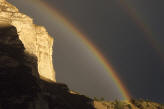|
|
|
|
|
 |
INTRODUCTION
The following list of questions is from the National
Park Service website, and is reflective of the questions which visitors
ask Park Rangers.
|
|
|
|
|
|
What is a hoodoo?
A hoodoo
is a pinnacle, spire or odd-shaped rock left standing by the forces of
erosion.
How long does it take to visit Bryce
Canyon?
It takes a minimum of 3 hours to drive to the 13 viewpoints along the
park's 38-mile (round-trip) scenic drive. In addition, there are hiking
trails, ranger programs, horseback rides, campgrounds and picnic areas to
greater enhance and extend your visit.
Are
Sunset and
Sunrise
Points the best places to view sunrise and sunset?
Not necessarily. Nearly all viewpoints face east and offer spectacular
views of the canyons bathed in morning's rich, dramatic light. The two
most popular viewpoints for sunrise are Sunrise Point and Bryce Point. For
sunset, pick your favorite overlook (we recommend Inspiration Point or
Paria View) and plan to arrive 1½ hours before sunset for the best
lighting.
Is Bryce Canyon really a canyon?
Yes and no. The park is actually an eroded escarpment of the Paunsaugunt
Plateau. There are about a dozen amphitheaters, or horseshoe-shaped
canyons, which scallop its eastern edge. The largest of these
amphitheaters is named Bryce Canyon.
Is the shuttle mandatory, or may I take
my own vehicle into the park?
The
shuttle is voluntary. It's a convenient way for visitors to tour the
park, without adding to traffic congestion and impacting park resources.
You are, however, welcome to bring your own vehicle into the park.
How did the park get its name?
Ebenezer Bryce, an immigrant from Scotland, moved with his family to the
Paria River valley in 1875. Bryce was sent by the Church of Jesus Christ
of Latter-day Saints because his skill as a carpenter would be useful in
settling the area. Local people called the canyon with strange rock
formations near Ebenezer's home, "Bryce's Canyon." The Bryces moved to
Arizona in 1880. To this day, people continue to call this area Bryce
Canyon.
What's the elevation of the park?
Park elevations reach 9,100 feet (2778 meters). People with heart or
respiratory problems should be especially careful not to overexert
themselves. Winters are typically long and cold, with an average of 96
inches of snow. Summers are mild and ideal for hiking and camping.
How far is it to Zion and Grand Canyon?
The east entrance of Zion National Park is 78 miles from Bryce Canyon. The
North Rim of the Grand Canyon is 150 miles from Bryce Canyon; the South
Rim is 300 miles.
What kind of
wildlife
am I likely to see?
Wildlife commonly seen at Bryce includes: Mule Deer, Utah Prairie Dogs,
Chipmunks, Golden-mantled Ground Squirrels, Pronghorn (antelope), Gray
Fox, Ravens, Steller's Jays, Clark's Nutcrackers, Red-tailed Hawks,
Turkeys, and Mountain Short-horned Lizards. Black Bear, Elk, and Mountain
Lions are rarely seen.
Is the park open year-round?
Yes, and we highly recommend visiting Bryce in the "off-season." Sixty
percent of our visitors come to Bryce Canyon June through September, but
October through May is a fantastic time to enjoy the park. In fall and
spring, there are fewer people, cooler temperatures, and spectacular fall
foliage and wildflower displays. In winter, deep snow blankets the plateau
and provides excellent cross-country skiing and snowshoeing opportunities.
Bryce Canyon's winter landscapes stagger the imagination, as dazzling
white snow contrasts beautifully with crimson-colored hoodoos.
|
|
|
Images and text courtesy of National Park Service. |
|

